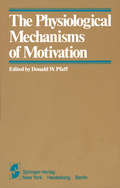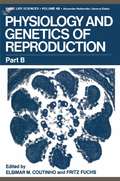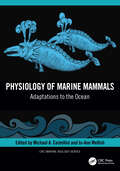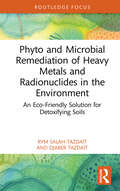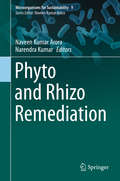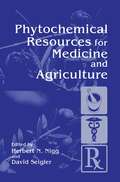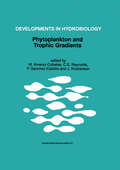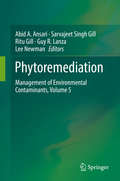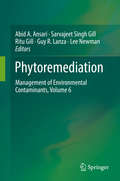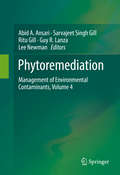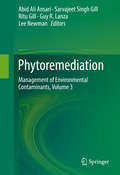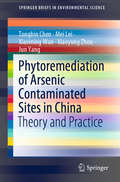- Table View
- List View
Physiological Ecology of the Alpine Timberline: Tree Existence at High Altitudes with Special Reference to the European Alps (Ecological Studies #31)
by W. TranquilliniIn the European Alps the importance of forests as protection against ava lanches and soil erosion is becoming ever clearer with the continuing increase in population and development of tourism. The protective potential of the moun tain forests can currently only be partially realised because a considerable propor tion of high-altitude stands has been destroyed in historical times by man's extensive clearing ofthe forests. The forests still remaining are of limited effec tiveness, due to inadequate density of trees and over-maturity. Considerable efforts, however, are now being made in the Alps and other mountains of the globe to increase the high-altitude forested area through reforestation, to raise depressed timberlines, and to restore remaining protection forests using suit able silvicultural methods to their full protective value. This momentous task, if it is to be successful, must be planned on a sound foundation. An important prerequisite is the assembly of scientific facts con cerning the physical environment in the protection forest zone of mountains, and the course of various life processes of tree species occurring there. Since the introduction of practical field techniques it has been possible to investigate successfully the reaction of trees at various altitudes to recorded factors, and the extent to which they are adapted to the measured situations. Such ecophysio logical studies enable us to recognize the site requirements for individual tree species, and the reasons for the limits of their natural distribution.
Physiological Effects of Noise: Based upon papers presented at an international symposium on the Extra-Auditory Physiological Effects of Audible Sound, held in Boston, Massachusetts, December 2830, 1969, in conjunction with the annual meeting of the American Association for the Advancement of Science
by Bruce WelchThe remarkable symposium arranged by Bruce L. Welch and Annemarie S. Welch for the meeting of the American Association for the Advancement of Science in Boston, Massachusetts at the end of the year 1969 was devoted to the physiological effects of audible sound. Dr. Welch and his wife were able to bring together a distinguished group of scientists from all parts of the world. It was very remarkable to be able to discuss the physiological aspects of noise with representative scientists from Israel, France, Germany, Hungary, Russia, Australia, Canada and Argentina. Dr. and Mrs. Welch ran the meeting in a delightful manner and continued to maintain interest and enthusiasm. Now the results of the conference are available. It is to be hoped that this volume will find wide interest and attention. We must differentiate noise from sound. Noise is unpleasant, unwanted or intolerable sound. On the other hand, even ordinary sound may at times be unpleasant, simply because we are not con ditioned to it. The general impression that one gets from reading the various reports on the physiological effects of noise is bad. It's a pollutant that we can each individually reduce, and maybe we can have a great enough effect socially so that we can significantly lower the noise levels which may result in considerable harm to us. It is interesting that noise as a pollutant has only recently attracted attention.
The Physiological Mechanisms of Motivation
by D. W. PfaffTo scientists engaged in research on the cellular mechanisms in the mammalian brain, concepts of "motivation" seem to be a logical neces sity, even if they are not fashionable. Immersed in the detailed, time consuming research required to deal with mammalian nerve cells, we usually pay scant attention to the more global brain -behavior questions that have arisen from decades of biological and psychological studies. We felt it was time to confront these issues-namely, how far has neuro biological investigation come in uncovering mechanisms by which moti vational signals influence behavior? At Rockefeller University, we have recently held a course on this subject. We restricted our treatment to those motivational systems most tractable to physiological approaches, and invited scientists skilled in both behavioral issues and physiological techniques to participate. This volume results from that course. The deans and administration at Rockefeller University provided much help in planning the course, and the staff of Springer-Verlag assisted in planning the book. Gabriele Zummer helped organize both the course and the processing of book chapters. They all deserve our thanks. December 1981 Donald W. Pfaff Professor of Neurobiology and Behavior Rockefeller University Contents Part One: Concepts. . . . . . . . . . . . . . . . . . . . . . . . . . . . . . . . . . . 1 Chapter 1 Donald W. Pfaff Motivational Concepts: Definitions and Distinctions . . . . . . . . . . 3 Motivation: A Brief Review of Concepts. . . . . . . . . . . . . . . . . . . . . . . . . . 5 Drive . . . . . . . . . . . . . . . . . . . . . . . . . . . . . . . . . . . . . . . . . . . . . . . . . . . . . . . . . . 10 Reinforcement, Reward . . . . . . . . . . . . . . . . . . . . . . . . . . . . . . . . . . . . . . . . . 13 Incentive . . . . . . . . . . . . . . . . . . . . . . . . . . . . . . . . . . . . . . . . . . . . . . . . . . . . . . 16 Arousal . . . . . . . . . . . . . . . . . . . . . . . . . . . . . . . . . . . . . . . . . . . . . . . . . . . . . . . 17 Emotion . . . . . . . . . . . . . . . . . . . . . . . . . . . . . . . . . . . . . . . . . . . . . . . . . . . . . . . 18 Motivation Is a Unitary Behavioral Concept with Multiple Neurophysiological Mechanisms. . . . . . . . . . . . . . . . . . . . . . . . . . . . . . . . . 20 References . . . . . . . . . . . . . . . . . . . . . . . . . . . . . . . . . . . . . . . . . . . . . . . . . . . . . 22 Chapter 2 Alan N.
Physiology and Ecology of Fish Migration
by Hiroshi Ueda Katsumi TsukamotoAmong the roughly 30,000 species of fish, migratory species account for only 165 species, but most of them are very important fisheries resources. This book presents up-to-date innovative research results on the physiology and ecology of fish migration. It focuses on salmon, eels, lampreys, and bluefin tuna. The book examines migratory behavior, sp
Physiology of Growth and Development in Horticultural Plants
by N. R. Bhat Arvind Bhatt M. K. SuleimanThe development of a plant is a multifaceted, dynamic phenomenon. Due to their immobility, plants respond not only to internal developmental cues, but also to changes in the prevailing environmental conditions. Climate change has increased vulnerability in plants due to increasing concentrations of CO2 and other pollutants, and fluctuations in the growing environment. These changes affect crop growth and productivity thereby posing a major risk to global food security. Physiology of Growth and Development in Horticultural Plants contains 22 chapters organized into six sections, beginning with an introduction on basic concepts of plant growth and development; followed by genetic basis of plant development; quantification of growth; and sensing and response of plants to various environmental signals. It also explores plant growth hormones and their role either singly or in combination in controlling various aspects of plant growth and development, and hormonal regulation of physiological and developmental processes. The book highlights intricate aspects of growth and development in horticultural plants with classic examples from the real world.Features· Presents information on plant growth and development; structure and genetic basis of plant development with quantification of growth; sensing and response of plants to various environmental signals; and various phytohormones and their role in controlling aspects of plant growth and development.· Provides key scientific and technical advances, issues, and challenges in various areas of growth and development of horticultural plants.· Demonstrates how the response of various plants to internal and external stimuli can be commercially exploited.Physiology of Growth and Development in Horticultural Plants encourages the development of new techniques, technologies and innovative practices, and is an ideal reference for students of advanced plant sciences courses, researchers, and commercial horticultural practitioners.
Physiology of Growth and Development in Horticultural Plants
by N. R. Bhat Arvind Bhatt M. K. SuleimanThe development of a plant is a multifaceted, dynamic phenomenon. Due to their immobility, plants respond not only to internal developmental cues, but also to changes in the prevailing environmental conditions. Climate change has increased vulnerability in plants due to increasing concentrations of CO2 and other pollutants, and fluctuations in the growing environment. These changes affect crop growth and productivity thereby posing a major risk to global food security. Physiology of Growth and Development in Horticultural Plants contains 22 chapters organized into six sections, beginning with an introduction on basic concepts of plant growth and development; followed by genetic basis of plant development; quantification of growth; and sensing and response of plants to various environmental signals. It also explores plant growth hormones and their role either singly or in combination in controlling various aspects of plant growth and development, and hormonal regulation of physiological and developmental processes. The book highlights intricate aspects of growth and development in horticultural plants with classic examples from the real world.Features· Presents information on plant growth and development; structure and genetic basis of plant development with quantification of growth; sensing and response of plants to various environmental signals; and various phytohormones and their role in controlling aspects of plant growth and development.· Provides key scientific and technical advances, issues, and challenges in various areas of growth and development of horticultural plants.· Demonstrates how the response of various plants to internal and external stimuli can be commercially exploited.Physiology of Growth and Development in Horticultural Plants encourages the development of new techniques, technologies and innovative practices, and is an ideal reference for students of advanced plant sciences courses, researchers, and commercial horticultural practitioners.
Physiology of Marine Mammals: Adaptations to the Ocean (CRC Marine Biology Series)
by Michael A. Castellini Jo-Ann MellishSuppose you were designing a marine mammal. What would they need to live in the ocean? How would you keep them warm? What design features would allow them to dive for very long periods to extreme depths? Do they need water to drink? How would they minimize the cost of swimming, and how would they find their prey in the deep and dark? These questions and more are examined in detail throughout Marine Mammal Physiology, which explores how marine mammals live in the sea from a physiological point of view. This undergraduate textbook considers the essential aspects of what makes a marine mammal different from terrestrial mammals, beyond just their environment. It focuses on the physiological and biochemical traits that have allowed this group of mammals to effectively exploit the marine environment that is so hostile to humans. The content of this book is organised around common student questions, taking the undergraduate's point of view as the starting point. Each chapter provides a set of PowerPoint slides for instructors to use in teaching and students to use as study guides. New "Study Questions" and "Critical Thinking Points" conclude each chapter, which are each motivated by a "Driving Question" such as "How do mammals stay warm in a cold ocean?" or "How do mammals survive the crushing pressures of the deep sea?" Full-colour images and comprehensive, accessible content make this the definitive textbook for marine mammal physiology.
Physiology of Marine Mammals: Adaptations to the Ocean (CRC Marine Biology Series)
Suppose you were designing a marine mammal. What would they need to live in the ocean? How would you keep them warm? What design features would allow them to dive for very long periods to extreme depths? Do they need water to drink? How would they minimize the cost of swimming, and how would they find their prey in the deep and dark? These questions and more are examined in detail throughout Marine Mammal Physiology, which explores how marine mammals live in the sea from a physiological point of view. This undergraduate textbook considers the essential aspects of what makes a marine mammal different from terrestrial mammals, beyond just their environment. It focuses on the physiological and biochemical traits that have allowed this group of mammals to effectively exploit the marine environment that is so hostile to humans. The content of this book is organised around common student questions, taking the undergraduate's point of view as the starting point. Each chapter provides a set of PowerPoint slides for instructors to use in teaching and students to use as study guides. New "Study Questions" and "Critical Thinking Points" conclude each chapter, which are each motivated by a "Driving Question" such as "How do mammals stay warm in a cold ocean?" or "How do mammals survive the crushing pressures of the deep sea?" Full-colour images and comprehensive, accessible content make this the definitive textbook for marine mammal physiology.
The Physiology of Thirst and Sodium Appetite (Nato Science Series A: #105)
by G. de Caro A.N. Epstein M. MassiThe behavioral neuroscience of thirst and sodium appetite are research ventures that have expanded dramatically in recent years. Work done in the mid-1950s and early 1960s made it clear that drinking behavior could be affected by direct manipulations of the brain, especially by brain damage and by pharmacological treat ments. Since that. time experimental approaches have diversified and the research enterprise has attracted the interest of a broad international community of scientists. Many aspects of both thirst and sodium appetite are being studied. The most prominent of these are: 1) phylogenetic and ontogenetic aspects of the phenomena of drink ing behavior, 2) the mechanisms of a variety of dipsogenic and antidipsogenic treatments, both drugs and hormones, 3) the biological controls of drinking and their interaction with the regulation of blood volume and blood pressure, 4) the peripheral signals of drinking including the role of the baro- and volume-receptors, 5) the receptor systems within the brain and the neuroanatomical circuitry for thirst and sodium appetite, and 6) the possible roles of brain sodium and of the hormones of sodium conservation ln the arousal of sodium appetite. This acceleration of basic research activity has given in sights into the clinical disorders of thirst and salt appetite and has produced pharmacological agents of potential therapeutic use.
Phyto and Microbial Remediation of Heavy Metals and Radionuclides in the Environment: An Eco-Friendly Solution for Detoxifying Soils (Routledge Focus on Environment and Sustainability)
by Rym Salah-Tazdaït Djaber TazdaïtThis book examines the role that bioremediation can play in the detoxification of soil, water, and air to improve environmental and human health, with a specific focus on heavy metals and radionuclides. Environmental pollution, whether by natural or human causes, with industrial activities being a key player, is a challenge facing all nations across the world. While treatment has typically required the use of expensive technology, one promising solution is the use of phytoremediation, in which plants act by metabolizing or sequestering pollutants. This eco-friendly solution is a good alternative to the standard methods of soil and water treatments. This book provides not only the basic definitions and classification of technologies used for contaminant remediation but also the most recent studies dealing with the selection of new promising microbial stains and plant varieties involved in the treatment of radioactive and heavy metal contaminants. It provides a detailed description of the biochemical mechanisms and genes involved in the bioremediation of radionuclides and heavy metals, offering a clear insight for academics and practitioners interested in in vitro and in situ biological treatment. This book will be of great value to students and scholars interested in environmental pollution and environmental health from across a range of different disciplines, including environmental microbiology and chemistry, ecology and environmental science, biological and environmental engineering and biotechnology.
Phyto and Microbial Remediation of Heavy Metals and Radionuclides in the Environment: An Eco-Friendly Solution for Detoxifying Soils (Routledge Focus on Environment and Sustainability)
by Rym Salah-Tazdaït Djaber TazdaïtThis book examines the role that bioremediation can play in the detoxification of soil, water, and air to improve environmental and human health, with a specific focus on heavy metals and radionuclides. Environmental pollution, whether by natural or human causes, with industrial activities being a key player, is a challenge facing all nations across the world. While treatment has typically required the use of expensive technology, one promising solution is the use of phytoremediation, in which plants act by metabolizing or sequestering pollutants. This eco-friendly solution is a good alternative to the standard methods of soil and water treatments. This book provides not only the basic definitions and classification of technologies used for contaminant remediation but also the most recent studies dealing with the selection of new promising microbial stains and plant varieties involved in the treatment of radioactive and heavy metal contaminants. It provides a detailed description of the biochemical mechanisms and genes involved in the bioremediation of radionuclides and heavy metals, offering a clear insight for academics and practitioners interested in in vitro and in situ biological treatment. This book will be of great value to students and scholars interested in environmental pollution and environmental health from across a range of different disciplines, including environmental microbiology and chemistry, ecology and environmental science, biological and environmental engineering and biotechnology.
Phyto and Rhizo Remediation (Microorganisms for Sustainability #9)
by Naveen Kumar Arora Narendra KumarThe increasing human population and the associated activities have negatively influenced the ecosystems and life on earth. The continuous addition of agrochemicals, heavy metals and industrial wastes/ effluents in the ecosystems have caused great harm, including loss of productivity, biodiversity, climate change and diseases in plants, animals and humans, resulting in increased marginal lands and endangered sustainability of life on earth. Hence, there is an urgent need to reverse the impact of dangerous pollutants through a holistic, sustainable and biotic approach. Bioremediation involves the utilization of biological systems, mainly plants (phytoremediation) or microorganisms or both in combination (rhizoremediation) for the removal or degradation of pollutants and revive the habitats in an eco-friendly manner. Recently, there have been many success stories related to bioremediation involving plants or plant-microbe interactions. These success stories are related to the removal of heavy metals, pesticides, polyaromatic hydrocarbons, explosives, radionuclides or reduction of biological oxygen demand, total dissolved solids, total suspended solids, oil spills in water bodies. Rhizoremediation has also been successfully used for reclamation of saline or marginal soils. With the range of pollutants and the total area (on earth) covered by these toxic chemicals, it is important that these eco-friendly technologies be utilized in a better way. The book throws light on the recent happenings, research and success stories related to bioremediation of polluted habitats through phytoremediation or rhizoremediation. The book also highlights some of the significantly important plant and microbial species involved in remediation, the physiology, biochemistry and the mechanisms of remediation by various plants and microbes, and suggestions for future improvement of bioremediation technology.
The Phytochemical Landscape: Linking Trophic Interactions and Nutrient Dynamics
by Mark D. HunterThe dazzling variation in plant chemistry is a primary mediator of trophic interactions, including herbivory, predation, parasitism, and disease. At the same time, such interactions feed back to influence spatial and temporal variation in the chemistry of plants. In this book, Mark Hunter provides a novel approach to linking the trophic interactions of organisms with the cycling of nutrients in ecosystems.Hunter introduces the concept of the "phytochemical landscape"—the shifting spatial and temporal mosaic of plant chemistry that serves as the nexus between trophic interactions and nutrient dynamics. He shows how plant chemistry is both a cause and consequence of trophic interactions, and how it also mediates ecosystem processes such as nutrient cycling. Nutrients and organic molecules in plant tissues affect decomposition rates and the fluxes of elements such as carbon, nitrogen, and phosphorus. The availability of these same nutrients influences the chemistry of cells and tissues that plants produce. In combination, these feedback routes generate pathways by which trophic interactions influence nutrient dynamics and vice versa, mediated through plant chemistry. Hunter provides evidence from terrestrial and aquatic systems for each of these pathways, and describes how a focus on the phytochemical landscape enables us to better understand and manage the ecosystems in which we live.Essential reading for students and researchers alike, this book offers an integrated approach to population-, community-, and ecosystem-level ecological processes.
The Phytochemical Landscape: Linking Trophic Interactions and Nutrient Dynamics
by Mark D. HunterThe dazzling variation in plant chemistry is a primary mediator of trophic interactions, including herbivory, predation, parasitism, and disease. At the same time, such interactions feed back to influence spatial and temporal variation in the chemistry of plants. In this book, Mark Hunter provides a novel approach to linking the trophic interactions of organisms with the cycling of nutrients in ecosystems.Hunter introduces the concept of the "phytochemical landscape"—the shifting spatial and temporal mosaic of plant chemistry that serves as the nexus between trophic interactions and nutrient dynamics. He shows how plant chemistry is both a cause and consequence of trophic interactions, and how it also mediates ecosystem processes such as nutrient cycling. Nutrients and organic molecules in plant tissues affect decomposition rates and the fluxes of elements such as carbon, nitrogen, and phosphorus. The availability of these same nutrients influences the chemistry of cells and tissues that plants produce. In combination, these feedback routes generate pathways by which trophic interactions influence nutrient dynamics and vice versa, mediated through plant chemistry. Hunter provides evidence from terrestrial and aquatic systems for each of these pathways, and describes how a focus on the phytochemical landscape enables us to better understand and manage the ecosystems in which we live.Essential reading for students and researchers alike, this book offers an integrated approach to population-, community-, and ecosystem-level ecological processes.
Phytochemical Resources for Medicine and Agriculture
by H. N. Nigg D. SeiglerThis book was tbe result of a symposium beld at tbe American Cbernical Society meeting in Miami Beacb, Florida, September 10-15, 1989. The symposium was jointly sponsored by Tbe Society for Economfc Botany and tbe American Cbernical Society Food and Natural Product sub division. Tbere were five speakers. During tbe social sessions (mostly over drinks in abotel room), it became obvious tbat, regardless of tbe discipline, we were all speaking tbe same language. Yet, prior to tbe symposium, only a few of tbe participants knew one anotber. We decided to expand tbe symposium into a book. The book would, we boped, accomplish for otbers wbat we bad discovered in ourselves. That is, the field of Natural Products is broad, but similar in techniques and approach, ancient but modern, and bas been and continues to be extremely valuable to humankind. We wanted the book to serve as an introductory text for courses and as a reference work for the future. We also determined to include the structure of every chemical in the chapter where it was mentioned so the reader would not have to find the structure somewhere else or to try and deduce the structure from the chemical name. Little did we know what an undertaking these goals would be or the time this would take.
Phytoplankton and Equilibrium Concept: Proceedings of the 13th Workshop of the International Association of Phytoplankton Taxonomy and Ecology (IAP), held in Castelbuono, Italy, 1–8 September 2002 (Developments in Hydrobiology #172)
by Luigi Naselli-Flores Judit Padisák Martin F. BachThis volume summarises the outcome of the 13th Workshop of the International Association of Phytoplankton Taxonomy and Ecology (IAP) on if, and if so under what conditions phytoplankton assemblages reach equilibrium in natural environments. Quite a number of ecological concepts use terms such as: ecological equilibrium, stability, steady-state, climax, stable state, etc. However, these ecological concepts often have been "translations" of scientific theories developed in physics or chemistry but they almost always lack scientific corroboration, the problem being that often these concepts remain vague and they are not formally defined. Here an attempt to formally recognize what "equilibrium" is in phytoplankton ecology is traced. The book also contains papers by leading scientists on the taxonomy of two selected key groups: cryptomonads and filamentous cyanoprokaryotes. This volume is addressed to all those involved in phytoplankton taxonomy and ecology and in ecology itself.
Phytoplankton and Trophic Gradients: Proceedings of the 10th Workshop of the International Association of Phytoplankton Taxonomy & Ecology (IAP), held in Granada, Spain, 21–29 June 1996 (Developments in Hydrobiology #129)
by M. Alvarez-Cobelas Colin S. Reynolds P. Sanchez-Castillo Jørgen KristiansenThese proceedings deal with the relationship between species composition of freshwater phytoplankton and the trophic gradient. Particular regard is paid to the composite question, what lives where and why? Overview papers report the state of the art and suggest that the trophic spectrum appears to be a probabilistic outcome of several dimensions of variability that impinge upon phytoplankton species selection. Studies on community structure span all latitudes from those of Antarctica to equatorial Brazil, and also include reports on light and nutrient gradients, pH and fish-stock effects on species composition. Seasonal and longterm phytoplankton dynamics in lakes of varying trophic status are also considered. Finally, studies on the taxonomy and autoecology of some groups (e.g. Volvocales, Chrysophytes and Euglenophytes) living at the extremes of the trophic spectrum contribute to our knowledge of this usually neglected phytoplankton. This is the first time that a book covers such a topic, and it will prove an excellent source of information to anyone working on phytoplankton ecology and ecological indicators. Limnologists in general, algologists and the technical staff at water authorities will all benefit by reading this book.
Phytoplasmas: Characterisation and Epidemiology of Phytoplasma - Associated Diseases
by Govind Pratap Rao Assunta Bertaccini Nicola Fiore Lia W. LieftingPhytoplasma-associated diseases are a major limiting factor to quality and productivity of many ornamentals, horticultural and other economically important agriculture crops worldwide. Annual losses due to phytoplasma diseases in many crops vary, but under the pathogen favorable conditions they always lead to disastrous consequences to farming community. As there is no effective cure for phytoplasma diseases, the management options emphasize on their exclusion, minimizing their spread by insect vectors and propagation materials and on development of host plant resistance. The phytoplasma associated plant diseases have a history of more than 50 years. Phytoplasmas have undoubtedly infected plants and cause diseases for centuries before they are described and proven to be the causal agents. But important progress related to identification of phytoplasmas only began after 1980’s. Phytoplasmas have emerged as the most serious constraints in the production of several crops all around the world during last four decades. Phytoplasmas constitute a major limiting factor to quality and productivity of cereals, horticultural, ornamentals and many other economically important crops all over the world. Annual losses due to phytoplasma diseases may vary, but under the pathogen favorable condition, phytoplasma disease may lead to disastrous consequences for farming and industry community. The scientific literature concerning phytoplasma occurrence, characterization, diagnosis, detection, and management is growing at a fast pace. Significant advancement in the last decades on diagnostic, biological and molecular properties, epidemiology, host-pathogen-insect interactions as well as management of phytoplasmas has been made. Till date, no authentic compilation is available to know the progress of phytoplasmas characterization major crops all over the world. The planned book will compile all the updated information available information on phytoplasmas by distinguished experts in the form of edited book entitled “Characterization and epidemiology of phytoplasma associated diseases”. The book covers recent and update information on emerging and re-emerging phytoplasma diseases affecting important crops in tropics and subtropics. It provides comprehensive information on disease distribution, occurrence, and identification of the phytoplasmas including the recent approaches for diagnostics, transmission, and information about losses and geographical distribution along with and management aspects. This volume contains 11-12 chapters contributed by the experienced and recognized experts working on different group of phytoplasmas affecting major crops all over the world. The information on various topics is at advanced as well as comprehensive level and provides the period wise developments of phytoplasma research. The book covers major chapters on an up to date progress of phytoplasma research, and then phytoplasma diseases associated with vegetable, pulse, oils crops, cereals, sugar crops, fruit crops, ornamentals, medicinal plants, palms species, forest tress and weeds. We have covered historical background, geographical distribution, identification and characterization, genetic diversity, host pathogen interaction and management aspects of important phytoplasma diseases infecting our major agricultural crops. The information on various topics is advanced as well as comprehensive, and provides thought provoking ideas for planning novel research ideas for future. This book will be useful to everyone interested in mollicutes, phytoplasma, spiroplasmas, plant pathology, disease control and plant biology and serve as an exhaustive and up-to-date compendium of references on various aspects of different groups of phytoplasmas affecting important crops worldwide.
Phytoremediation: Management of Environmental Contaminants, Volume 5
by Abid A. Ansari Sarvajeet Singh Gill Ritu Gill Guy R. Lanza Lee NewmanThis text details the plant-assisted remediation method, “phytoremediation”, which involves the interaction of plant roots and associated rhizospheric microorganisms for the remediation of soil contaminated with high levels of metals, pesticides, solvents, radionuclides, explosives, crude oil, organic compounds and various other contaminants. Many chapters highlight and compare the efficiency and economic advantages of phytoremediation to currently practiced soil and water treatment practices.Volume 5 of Phytoremediation: Management of Environmental Contaminants provides the capstone of the series. Taken together, the five volumes provide a broad–based global synopsis of the current applications of phytoremediation using plants and the microbial communities associated with their roots to decontaminate terrestrial and aquatic ecosystems.
Phytoremediation: Management of Environmental Contaminants, Volume 6
by Abid A. Ansari Sarvajeet Singh Gill Ritu Gill Guy R. Lanza Lee NewmanThis text details the plant-assisted remediation method, “phytoremediation”, which involves the interaction of plant roots and associated rhizospheric microorganisms for the remediation of soil contaminated with high levels of metals, metalloids, fuel and oil hydrocarbons, nano particles, pesticides, solvents, organic compounds and various other contaminants. Many chapters highlight and compare the efficiency and economic advantages of phytoremediation and nano-phytoremediation to currently practiced soil and water treatment practices.Volume 6 of Phytoremediation: Management of Environmental Contaminants continues the series. Taken together, the six volumes provide a broad–based global synopsis of the current applications of phytoremediation using plants and the microbial communities associated with their roots to decontaminate terrestrial and aquatic ecosystems.
Phytoremediation: Management of Environmental Contaminants, Volume 4
by Abid A. Ansari Sarvajeet Singh Gill Ritu Gill Guy R. Lanza Lee NewmanThis text details the plant-assisted remediation method, “phytoremediation," which involves the interaction of plant roots and associated rhizospheric microorganisms for the remediation of soil contaminated with high levels of metals, pesticides, solvents, radionuclides, explosives, crude oil, organic compounds and various other contaminants. Each chapter highlights and compares the beneficial and economical alternatives of phytoremediation to currently practiced soil removal and burial practices.
Phytoremediation: Management of Environmental Contaminants, Volume 3
by Abid Ali Ansari Sarvajeet Singh Gill Ritu Gill Guy R. Lanza Lee NewmanThis book details the plant-assisted remediation method, “phytoremediation”, which involves the interaction of plant roots and associated rhizospheric microorganisms for the remediation of soil contaminated with high levels of metals, pesticides, solvents, radionuclides, explosives, crude oil, organic compounds and various other contaminants. Each chapter highlights and compares the beneficial and economical alternatives of phytoremediation to currently practiced soil removal and burial practices.
Phytoremediation of Arsenic Contaminated Sites in China: Theory and Practice (SpringerBriefs in Environmental Science)
by Tongbin Chen Mei Lei Xiaoming Wan Xiaoyong Zhou Jun YangThis book introduces readers to the main theories of phytoremediation and its application to arsenic-contaminated soils in China. The hyperaccumulation theories are introduced, including the use of hyperaccumulators to remove large amounts of arsenic without producing toxic symptoms. The use of synchrotron-based X-ray absorption fine structure radiation to disclose the hyperaccumulation mechanism – a method that makes it possible to detect the elements in plant tissues without destroying the sample – is introduced in detail. This book also includes practical application cases of phytoremediation, which are rarely found in the literature. Allowing readers to gain a thorough understanding of phytoremediation technology, and demonstrating its efficiency in cleaning arsenic-contaminated soils, the book offers a valuable asset for graduate students, lecturers, researchers and engineers in the field of soil remediation.
Phytoremediation of Metal-Contaminated Soils (Nato Science Series: IV: #68)
by Jean-Louis Morel Guillaume Echevarria Nadezhda GoncharovaThis is the first book aimed at development of a common language among scientists working in the field of Phytoremediation. Authors of the main chapters are leading scientists in this field. Some of them were among the first ones to have suggested the use of hyperaccumulator plants for extraction of metals from soils. Manuscripts based on lectures presented at the ASI have been revised here to take into account ASI participants’ comments and suggestions.


